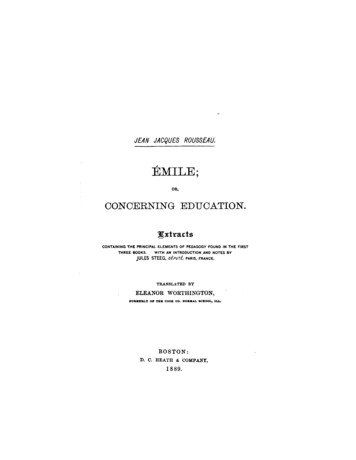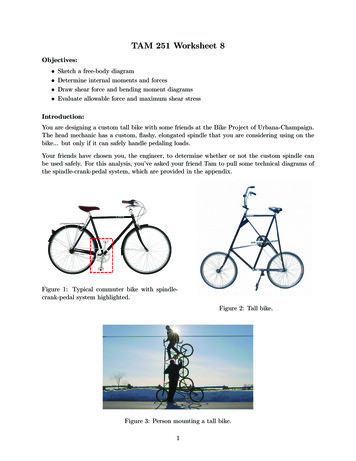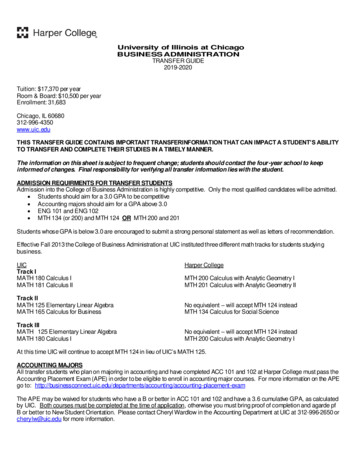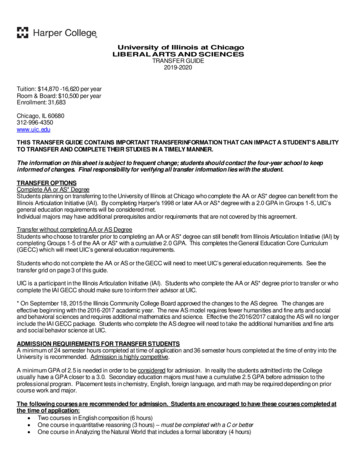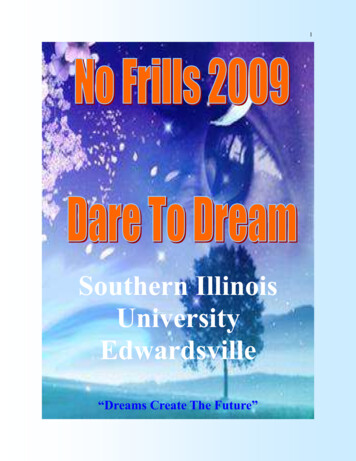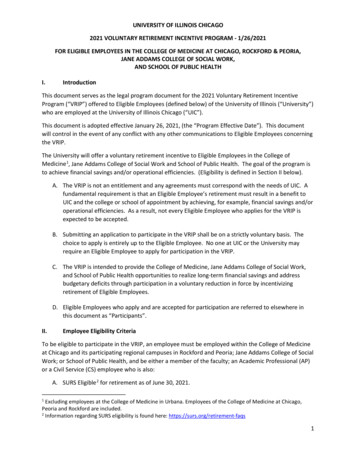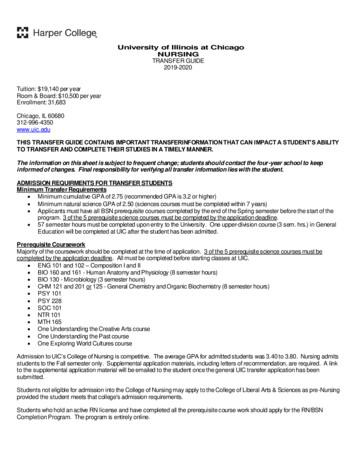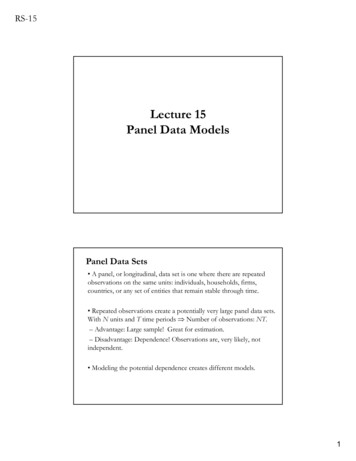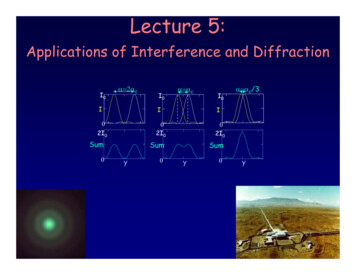
Transcription
Lecture 5:Applications of Interference and DiffractionI0α 2αcI0α αcI0III02I002I002I0SumSum0.5Sum0y0y0α αc/3yLecture 5, p 1
TodayCircular Diffraction Angular resolution (Rayleigh’s criterion) Minimum spot sizeInterferometers Michelson ApplicationsLecture 5, p 2
Diffraction-limited OpticsDiffraction has important implications for optical instrumentsEven for perfectly designed optics the image of a point sourcewill be a little blurry - the circular aperture produces diffraction.ImageplaneDθI0Image planeIPoint object00θoθThe size of the spot is determined by the diameter, D,of the aperture, and wavelength, λ, of the incident light.The “Airy disk”.The central lobe contains84% of power.Diffraction by a circular aperture is similar to single-slitdiffraction. But note the difference:Slitθ0 λaCircularapertureθ0 1.22λDLecture 5, p 3
Slits and circular aperturesI0IMonochromatic lightsource at a greatdistance, or a laser.Slit,width aObservationscreen:0-λ/a0λaθI0Pinhole,diameter DObservationscreen:I0-1.22λ/D 0Object at anydistance:1.22λ/D θImage Plane:Lens,diameter DThe focusing effect of the lens is independentof the diffraction effect due to the apertureLecture 5, p 4
Exercise: Expansion of a Laser beamIn 1985, a laser beam with a wavelength of λ 500 nm was firedfrom the earth and reflected off the space shuttle Discovery, in orbitat a distance of L 350 km away from the laser.If the circular aperture of the laser was D 4.7 cm, what was thebeam diameter d at the space shuttle?DdLecture 5, p 5
SolutionIn 1985, a laser beam with a wavelength of λ 500 nm was firedfrom the earth and reflected off the space shuttle Discovery, in orbitat a distance of L 350 km away from the laser.If the circular aperture of the laser was D 4.7 cm, what was thebeam diameter d at the space shuttle?dDHalf-angle-width ofdiffraction maximum:λ500 10 9θo 1.22 1.22 1.3 10 5 radians 2D4.7 10d 2θoL 2(1.3 10 5 )(350 103 m) 9.1 mLecture 5, p 6
Act 1In 1985, a laser beam with a wavelength of λ 500 nm was firedfrom the earth and reflected off the space shuttle Discovery, in orbitat a distance of L 350 km away from the laser.dDTo make a smaller spot on the shuttle, what should we do to thebeam diameter at the source?a. reduce itb. increase itc. cannot be made smallerLecture 5, p 7
SolutionIn 1985, a laser beam with a wavelength of λ 500 nm was firedfrom the earth and reflected off the space shuttle Discovery, in orbitat a distance of L 350 km away from the laser.dDTo make a smaller spot on the shuttle, what should we do to thebeam diameter at the source?a. reduce itb. increase itc. cannot be made smallerCounter-intuitive as this is, it is correct – you reduce beam divergenceby using a bigger beam. (Note: this will work as long as D d.)We’ll see that this can be understood as a non-quantumversion of the uncertainty principle: x px .Lecture 5, p 8
Exercise: Focusing a laser beamThere are many times you would like to focus a laser beam to assmall a spot as possible. However, diffraction limits this.DlensdDlaserfThe circular aperture of a laser (λ 780 nm) has Dlaser 5 mm.What is the spot-size d of the beamafter passing through a perfect lens with focal length f 5mmand diameter Dlens 6 mm?Lecture 5, p 9
SolutionThere are many times you would like to focus a laser beam to assmall a spot as possible. However, diffraction limits this.DlensdDlaserfThe circular aperture of a laser (λ 780 nm) has Dlaser 5 mm.What is the spot-size d of the beamafter passing through a perfect lens with focal length f 5mmand diameter Dlens 6 mm?The angular spread of the beam is determined by the smaller ofDlaser and Dlens. Here, it’s Dlaser.θ o 1.22λ / DlaserLight at this angle will intercept the focal plane at d/2 f θο.d 2θo f 2.44λf / Dlaser 2.44(0.78µm)(5mm) /(5mm) 1.9µmLecture 5, p 10
Act 2There are many times you would like to focus a laser beam to assmall a spot as possible. However, diffraction limits this.DlensdDlaser(See lecture 4, exercise 2)fλ 780 nm, Dlaser 5 mm, f 5 mm, Dlens 6 mm.Which of the following will reduce the spot size?a. increase λb. decrease λc. increase Dlensd. decrease DlensLecture 5, p 11
SolutionThere are many times you would like to focus a laser beam to assmall a spot as possible. However, diffraction limits this.DlensdDlaser(See lecture 4, exercise 2)fλ 780 nm, Dlaser 5 mm, f 5 mm, Dlens 6 mm.Which of the following will reduce the spot size?a. increase λb. decrease λc. increase Dlensd. decrease DlensThe diffraction is already limited by Dlaser. Increasing Dlens doesn’t help.There is a huge industry devoted to developing cheap blue diode lasers(λ 400 nm) for just this purpose, i.e., to increase DVD capacity.“Blue-Ray” technology!Lecture 5, p 12
Lecture 5, p 13
Angular ResolutionDiffraction also limits our ability to “resolve” (i.e., distinguish) two point sources.Consider two point sources (e.g., stars) with angular separation α viewedthrough a circular aperture or lens of diameter D.Two pointsourcesDααα 2αcα αc/3α αcI0I0I0I0.5IIα c 1.220002I02I02I0SumSumSum0Rayleigh’s Criteriondefines the images to beresolved if the centralmaximum of one imagefalls on or further than thefirst minimum of thesecond image.yTwo imagesresolvable0y‘Diffraction limit’of resolution0yTwo imagesnot resolvableλDNOTE:No interference!!Why not?Lecture 5, p 14
FYI:Coherent and Incoherent WavesWe only observe interference when the sources have a definite(usually constant) phase difference. In this case, the sourcesare said to be coherent. Examples of coherent sources:Sound waves from speakers driven by electrical signals thathave the same frequency and a definite phase.Laser light. In a laser, all the atoms emit light with the samefrequency and phase. This is a quantum effect that we’ll studylater in the course.LaserThe laser light is also allgoing the same direction.Incoherent waves: The phase relation is random.Waves from two unrelated sources. Examples: light from two points on the sun or two atoms on a lightbulb filament, or two people singing the same note. Incoherent intensities add. The average of constructive anddestructive interference is no interference!Lecture 3, p 15
Act 3: Resolving StarsHalley’sComet1. Assuming diffraction-limited optics, what is the minimum angularseparation of two stars that can be resolved by a D 5 m telescopeusing light of λ 500 nm?a. 0.1 µradb. 1 µradc. 10 µrad2. If the two point sources are not quite resolved at screen 1, willthey be resolved at screen 2?a. Yesb. Noscreen 1screen 2Lecture 5, p 16
SolutionHalley’sComet1. Assuming diffraction-limited optics, what is the minimum angularseparation of two stars that can be resolved by a D 5 m telescopeusing light of λ 500 nm?a. 0.1 µradα c 1.22λDb. 1 µradc. 10 µrad 1 10 7 0.1µ rad2. If the two point sources are not quite resolved at screen 1, willthey be resolved at screen 2?a. Yesb. Noscreen 1screen 2Lecture 5, p 17
SolutionHalley’sComet1. Assuming diffraction-limited optics, what is the minimum angularseparation of two stars that can be resolved by a D 5 m telescopeusing light of λ 500 nm?a. 0.1 µradα c 1.22λDb. 1 µradc. 10 µrad 1 10 7 0.1µ rad2. If the two point sources are not quite resolved at screen 1, willthey be resolved at screen 2?a. Yesb. Noαc only depends on λ and D. The centers of the spots are fartherapart, but the spots are also wider by the same amount.screen 1screen 2Lecture 5, p 18
Example: Camera resolution(Next week’s discussion)Photosensor:Aperture,D 3 mmDigital cameras looksomething like this:5 mmPhotosensorlens7 mmFocal lengthf 10 mmPixelIf the distance between adjacent pixels is less than the minimum resolvableseparation due to diffraction, then diffraction limits the image quality.dThe “f-number” of a lens is defined as f/D. To minimize diffraction,you want a small f-number, i.e., a large aperture*.*This assumes a ‘perfect lens’. In practice, lens aberrations limit the resolution if D is too big.Lecture 5, p 19
Optical InterferometersInterference arises whenever there are two (or more) ways for somethingto happen, e.g., two slits for the light to get from the source to the screen.I 4I1cos2(φ/2), with φ 2πδ/λ, and path-length difference δAn interferometer is a device using mirrors and “beam splitters”(half of the light is transmitted, half is reflected) to givetwo separate paths from source to detector.Two common types:Mach-Zehnder:beam-splittermirrorMichelson :mirrorbeamsplittermirrorsbeamsplitterLecture 5, p 20
Michelson InterferometerThe Michelson interferometer works by varying the phase differencebetween the two paths the light can take.One possibility is to vary the lengths L1 or L2.This makes possible very accurate measurements of displacements.mirrorTotal pathlength L12I12I1Path-lengthdifferenceδ L2 - L1Total pathlength L2SourceBe careful !!What’s importantis the total time toget back to thebeam splitter.2I14I1mirror2I1beamsplitterI1I1I 4I1 cos2(φ/2), with φ 2π δ/λLecture 5, p 21
ACT 4Consider the following Michelson interferometer. Supposethat for the setup shown, all the light (with λ 500 nm)comes out the bottom port.d1. How much does the top mirror need to be moved sothat none of the light comes out the bottom port?a. 125 nmb. 250 nmc. 500 nm2. Where does the light then go?a. downb. upc. leftd. rightLecture 5, p 22
SolutionConsider the following Michelson interferometer. Supposethat for the setup shown, all the light (with λ 500 nm)comes out the bottom port.d1. How much does the top mirror need to be moved sothat none of the light comes out the bottom port?a. 125 nmb. 250 nmc. 500 nmWe need to go from complete constructive to completedestructive interference Δφ 180 δ λ/2.HoweverOwhen we move the mirror by d, we change δ by 2d.Therefore, d δ/2 λ/4 500/4 125 nm.2. Where does the light then go?a. downb. upc. leftd. rightLecture 5, p 23
SolutionConsider the following Michelson interferometer. Supposethat for the setup shown, all the light (with λ 500 nm)comes out the bottom port.d1. How much does the top mirror need to be moved sothat none of the light comes out the bottom port?a. 125 nmb. 250 nmc. 500 nmWe need to go from complete constructive to completedestructive interference Δφ 180 δ λ/2.HoweverOwhen we move the mirror by d, we change δ by 2d.Therefore, d δ/2 λ/4 500/4 125 nm.2. Where does the light then go?a. downb. upc. leftd. rightThe light goes out the way it came in.Energy is conserved --the light can’t just disappear!The Michelson interferometer is perhaps most famous for disprovingthe hypothesis that EM waves propagate through an “aether” – thisresult helped stimulate the Special Theory of RelativityLecture 5, p 24
Michelson InterferometerAnother possibility is to vary the phase by changing the speed of the waves inthe two arms.Recall v c/n where n index of refraction.Using λ v/f, the number of wavelengths in arm 1 is:N1 Lλ1 n1f Lcand similarly for arm 2.(You can think of it as the path being longer by n.)The phase difference is thus:φ 2π(N1 – N2) 2π(fL/c)(n1 – n2)This makes possible very accurate measurement of changes in the speed oflight in the two arms.mirrorbeamsplitterLecture 5, p 25
FYI: ApplicationOptical Coherence Tomography One “mirror” of the Michelson is replacedby human tissue. The type of tissuecontrols the amount of reflection andthe phase shift.By sending in many colors, one canlearn about the density, composition,and structure of the tissue.Used for medical diagnostics – like amicroscope, but you don’t have to excisethe sample from the body!Used to study skin cancercardiovascular disease (detect bad plaques)glaucoma and macular degeneration (incurable eye disease)Lecture 5, p 26
FYI: Gravitational Wave DetectionGeneral relativity predicts that when massive objects accelerate, theyproduce time-dependent gravitational fields – gravitational waves –that propagate as “warpings” of spacetime at the speed of light.(similar to EM radiation from accelerated charge)The effect is very tiny: E.g., estimated L/L of 10-21 for in-spiralingbinary neutron stars. How to detect this?Lecture 5, p 27
FYI: Application: Gravity Wave DetectionLIGO:LaserInterferometricGravitational waveObservatory-World’s largest interferometers: 4-km-2 in Hanford, WA; 1 in Livingston, LO- 500 scientists-Achieved sensitivity L/L 10-23 L 10-20 m-Six data runs completed.-“Advanced LIGO” should improve sensitivity by another 10x.Lecture 5, p 28
FYI: Modern Applications in NavigationConsider the following “Sagnac” [“sahn-yack”]interferometer. Here the two possible pathsare the clockwise and counter-clockwisecircuits around the fiber loop.1. If we insert an extra piece of glass as shown,how does the relative path length change?fiberloop2. How could we change the relative path-length difference, andthereby change how much light exits the bottom port?
FYI: Modern Applications in NavigationConsider the following “Sagnac” [“sahn-yack”]interferometer. Here the two possible pathsare the clockwise and counter-clockwisecircuits around the fiber loop.fiberloop1. If we insert an extra piece of glass as shown,how does the relative path length change?It doesn’t! Because the interference paths completely overlap,the Sagnac is a remarkably stable interferometer, e.g., totemperature fluctuations in the fiber.2. How could we change the relative path-length difference, andthereby change how much light exits the bottom port?
FYI: Modern Applications in NavigationConsider the following “Sagnac” [“sahn-yack”]interferometer. Here the two possible pathsare the clockwise and counter-clockwisecircuits around the fiber loop.fiberloop1. If we insert an extra piece of glass as shown,how does the relative path length change?It doesn’t! Because the interference paths completely overlap,the Sa
Angular resolution (Rayleigh’s criterion) Minimum spot size Interferometers Michelson Applications. Lecture 5, p 3 The size of the spot is determined by the diameter, D , of the aperture, and wavelength, λ, of the incident light. Diffraction by a circular aperture is similar to single-slit diffraction. But note the difference: Image plane 0 0 I I0 θ θ o θ D Image plane Point object a λ .

